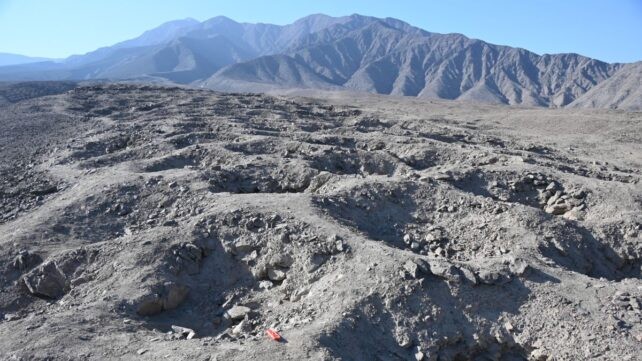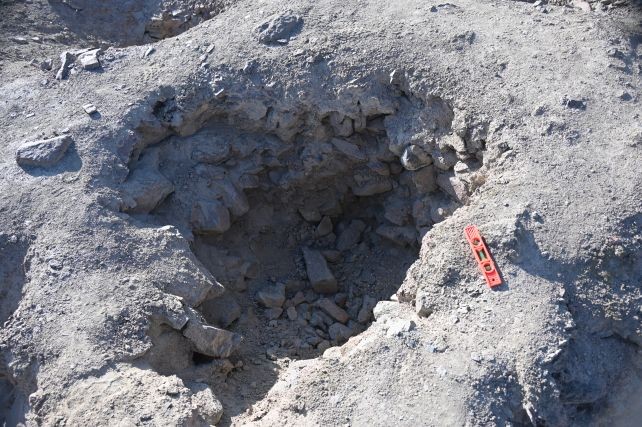The 5,200 Mystery Holes in Peru Have a Purpose—and It Changes Everything
Hundreds of years ago, someone took great pains to carve thousands of holes into a long ridge-top strip in the Andean foothills. It has baffled the world since 1933, when the National Geographic Society published Robert Shippee's aerial photographs of the strange site. Now archaeologists think they know the answer. Monte Sierpe is a monumental work of landscape engineering. The long strip is 1.5 kilometers (0.93 miles) long and about seven to eight holes wide. It comprises some 5,200 holes excavated from the sediment, some deliberately reinforced at the sides using stones. It would have required significant planning and time, which leads to the obvious questions: Who, and why? Proposed explanations have ranged from gardening to fog collection.

In This Article:
Monte Sierpe: A Monumental Structure That Asks Big Questions
An analysis of plant material found inside the holes suggests that it may have initially functioned as a market and later as an accounting system, says a team led by archaeologist Jacob Bongers of the University of Sydney in Australia. "Why would ancient peoples make over 5,000 holes in the foothills of southern Peru? Were they gardens? Did they capture water? Did they have an agricultural function?" Bongers says. "We don't know why they are here, but we have produced some promising new data that yield important clues and support novel theories about the site's use." Humans don't tend to undertake major construction works unless there's a purpose, and Monte Sierpe is a monumental work of landscape engineering. The long strip of holes measures 1.5 kilometers (0.93 miles) long and around seven or eight holes wide. It consists of some 5,200 holes excavated from the sediment, some deliberately reinforced at the sides using stones. It would have required significant planning and time, which leads to the obvious questions: Who, and why? Proposed explanations have ranged from gardening to fog collection. Bongers and his colleagues built on previous work that proposed the site was used as a system of taxation by the Inca. The archaeologists conducted extensive fieldwork, mapping the site with drones and testing sediment samples from inside the holes to determine which materials, if any, may have been placed there, and how long ago. The Inca empire moved into the region around 1400 CE, so scientists have been operating under the assumption that Monte Sierpe is an Inca site. However, the Inca culture wasn't the first to live there; before their expansion into the region, the Chincha culture had lived there for hundreds of years. Radiocarbon dating of charcoal from one of the pits revealed it was deposited around 1320 to 1405 CE – a timing that suggests the material predates the Inca. If so, it suggests the Chincha likely built and used the site well before the Inca arrived. Pottery fragments found on the surface support the same timeframe.

Contents of the Holes Point to a Pre‑Inca Marketplace and a Growing Accounting System
The most significant revelation, the researchers say, is the contents of the holes. Their microbotanical analysis of sediments from 19 holes yielded starch and pollen grains of maize (corn), Amaranthaceae (the plant group that includes quinoa, spinach, beets, and chard), Pooidae (the grass subfamily that includes cereals such as oats, wheat, and barley), and Cucurbita (squash). Other plant materials found included bulrush and willow species used in basketmaking. Taken together, these results suggest that the holes once contained food plants held in the baskets used to transport them. "This is very intriguing," Bongers says. "Perhaps this was a pre-Inca marketplace, like a flea market. We know the pre-Hispanic population here was around 100,000 people. Perhaps mobile traders (seafaring merchants and llama caravans), specialists (farmers and fisherfolk), and others were coming together at the site to exchange local goods such as corn and cotton." Yet aerial imagery of the site revealed a pattern that is not as apparent from the ground. The holes are arranged in blocks that, the researchers say, are remarkably similar to an Inca khipu, a knotted-string counting device recovered from the same Andean valley. This suggests that the later Inca repurposed the holes for tax collection, using them as a tribute register to ensure the appropriate levies were collected. "Fundamentally, I view these holes as a type of social technology that brought people together, and later became a large-scale accounting system under the Inca Empire," Bongers says. "There are still many more questions – why is this monument only seen here and not all over the Andes? Was Monte Sierpe a sort of 'landscape khipu'? – but we are getting closer to understanding this mysterious site. It is very exciting." The next step is a second phase of fieldwork to collect more samples, date more of the pits, and study more of the local khipus to validate and build upon these fascinating findings. The research has been published in Antiquity.

From Market to Accounting: The Inca Connection and What Comes Next
The aerial pattern of Monte Sierpe points to a transformative use: a later Inca repurposing of the holes as a tax-collection system, aligned with the knotted-string khipu tradition. "Fundamentally, I view these holes as a type of social technology that brought people together, and later became a large-scale accounting system under the Inca Empire," Bongers says. "There are still many more questions – why is this monument only seen here and not all over the Andes? Was Monte Sierpe a sort of 'landscape khipu'? – but we are getting closer to understanding this mysterious site. It is very exciting." The researchers also note that the next step is a second phase of fieldwork to collect more samples, date more of the pits, and study more of the local khipus to validate and build upon these fascinating findings. The research has been published in Antiquity.

